MGMT 6015 - International Business Strategy: Billabong in India
VerifiedAdded on 2023/06/10
|12
|3068
|131
Report
AI Summary
This report provides a detailed analysis of Billabong's international business strategy, focusing on its potential entry into the Indian market. It explores key modern economic theories such as the theory of absolute advantage, the theory of comparative advantage, and Porter's economic theory, and examines their applicability to Billabong's operations. The report also utilizes the Canvas business model to outline Billabong's key partners, activities, value propositions, customer relationships, customer segments, key resources, channels, cost structure, and revenue streams. Furthermore, it assesses the strengths and weaknesses of the Canvas model and discusses strategies for improvement. The impact of global competition on Billabong's business model is analyzed, along with the characteristics of the Indian market and the risks and challenges associated with entering it. The report concludes with mitigations to reduce these risks and challenges, including a PESTLE analysis to identify opportunities and threats in the Indian market.
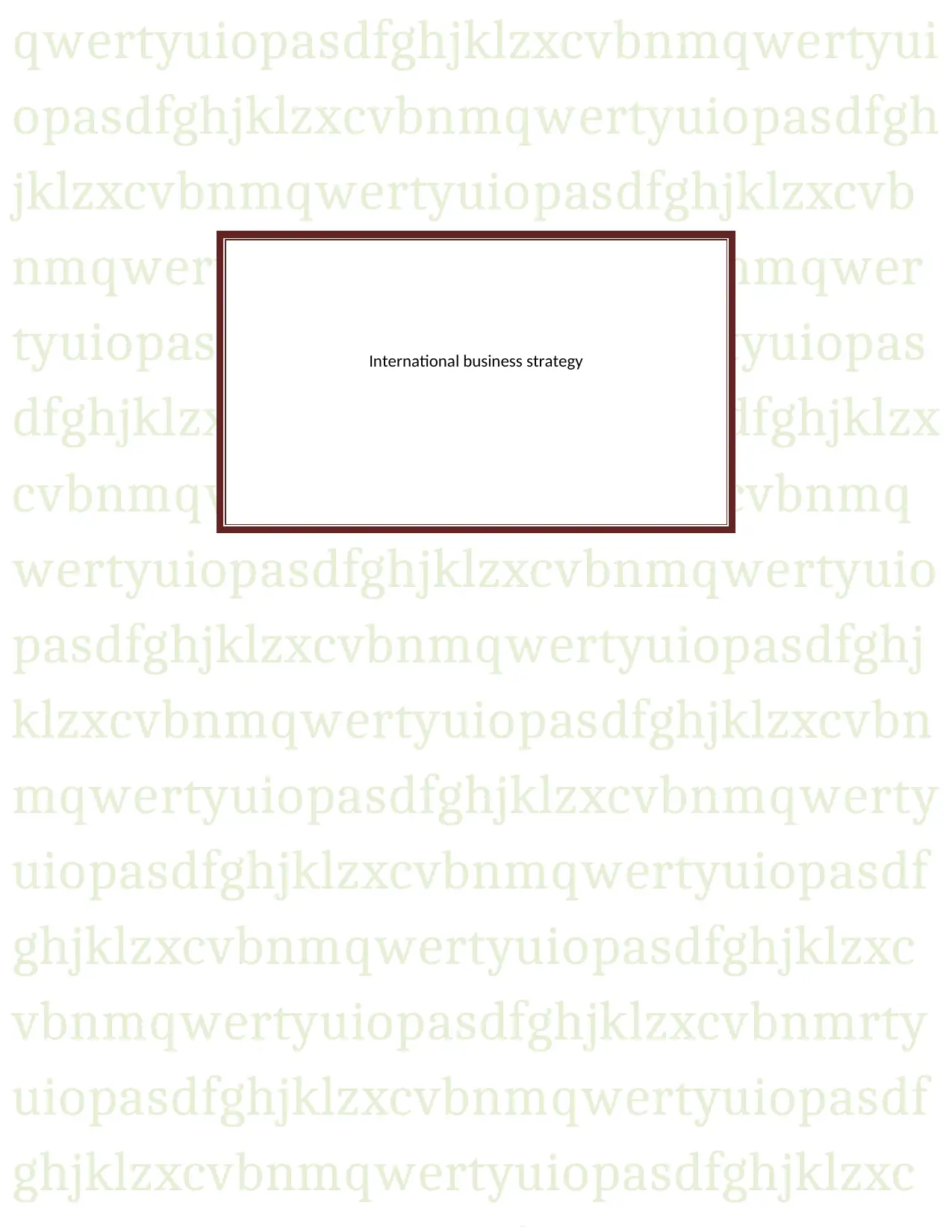
qwertyuiopasdfghjklzxcvbnmqwertyui
opasdfghjklzxcvbnmqwertyuiopasdfgh
jklzxcvbnmqwertyuiopasdfghjklzxcvb
nmqwertyuiopasdfghjklzxcvbnmqwer
tyuiopasdfghjklzxcvbnmqwertyuiopas
dfghjklzxcvbnmqwertyuiopasdfghjklzx
cvbnmqwertyuiopasdfghjklzxcvbnmq
wertyuiopasdfghjklzxcvbnmqwertyuio
pasdfghjklzxcvbnmqwertyuiopasdfghj
klzxcvbnmqwertyuiopasdfghjklzxcvbn
mqwertyuiopasdfghjklzxcvbnmqwerty
uiopasdfghjklzxcvbnmqwertyuiopasdf
ghjklzxcvbnmqwertyuiopasdfghjklzxc
vbnmqwertyuiopasdfghjklzxcvbnmrty
uiopasdfghjklzxcvbnmqwertyuiopasdf
ghjklzxcvbnmqwertyuiopasdfghjklzxc
International business strategy
opasdfghjklzxcvbnmqwertyuiopasdfgh
jklzxcvbnmqwertyuiopasdfghjklzxcvb
nmqwertyuiopasdfghjklzxcvbnmqwer
tyuiopasdfghjklzxcvbnmqwertyuiopas
dfghjklzxcvbnmqwertyuiopasdfghjklzx
cvbnmqwertyuiopasdfghjklzxcvbnmq
wertyuiopasdfghjklzxcvbnmqwertyuio
pasdfghjklzxcvbnmqwertyuiopasdfghj
klzxcvbnmqwertyuiopasdfghjklzxcvbn
mqwertyuiopasdfghjklzxcvbnmqwerty
uiopasdfghjklzxcvbnmqwertyuiopasdf
ghjklzxcvbnmqwertyuiopasdfghjklzxc
vbnmqwertyuiopasdfghjklzxcvbnmrty
uiopasdfghjklzxcvbnmqwertyuiopasdf
ghjklzxcvbnmqwertyuiopasdfghjklzxc
International business strategy
Paraphrase This Document
Need a fresh take? Get an instant paraphrase of this document with our AI Paraphraser
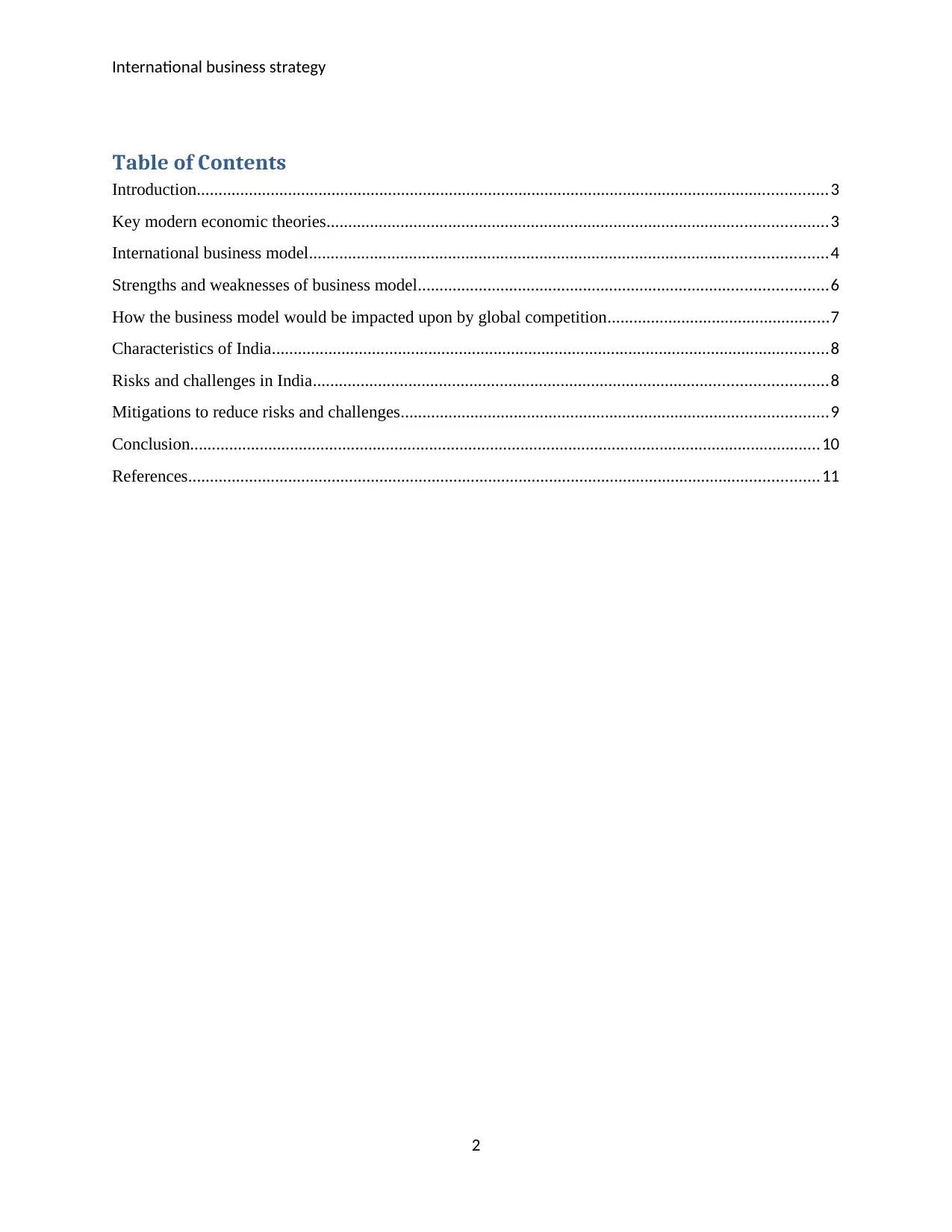
International business strategy
Table of Contents
Introduction.................................................................................................................................................3
Key modern economic theories...................................................................................................................3
International business model.......................................................................................................................4
Strengths and weaknesses of business model..............................................................................................6
How the business model would be impacted upon by global competition...................................................7
Characteristics of India................................................................................................................................8
Risks and challenges in India......................................................................................................................8
Mitigations to reduce risks and challenges..................................................................................................9
Conclusion.................................................................................................................................................10
References.................................................................................................................................................11
2
Table of Contents
Introduction.................................................................................................................................................3
Key modern economic theories...................................................................................................................3
International business model.......................................................................................................................4
Strengths and weaknesses of business model..............................................................................................6
How the business model would be impacted upon by global competition...................................................7
Characteristics of India................................................................................................................................8
Risks and challenges in India......................................................................................................................8
Mitigations to reduce risks and challenges..................................................................................................9
Conclusion.................................................................................................................................................10
References.................................................................................................................................................11
2
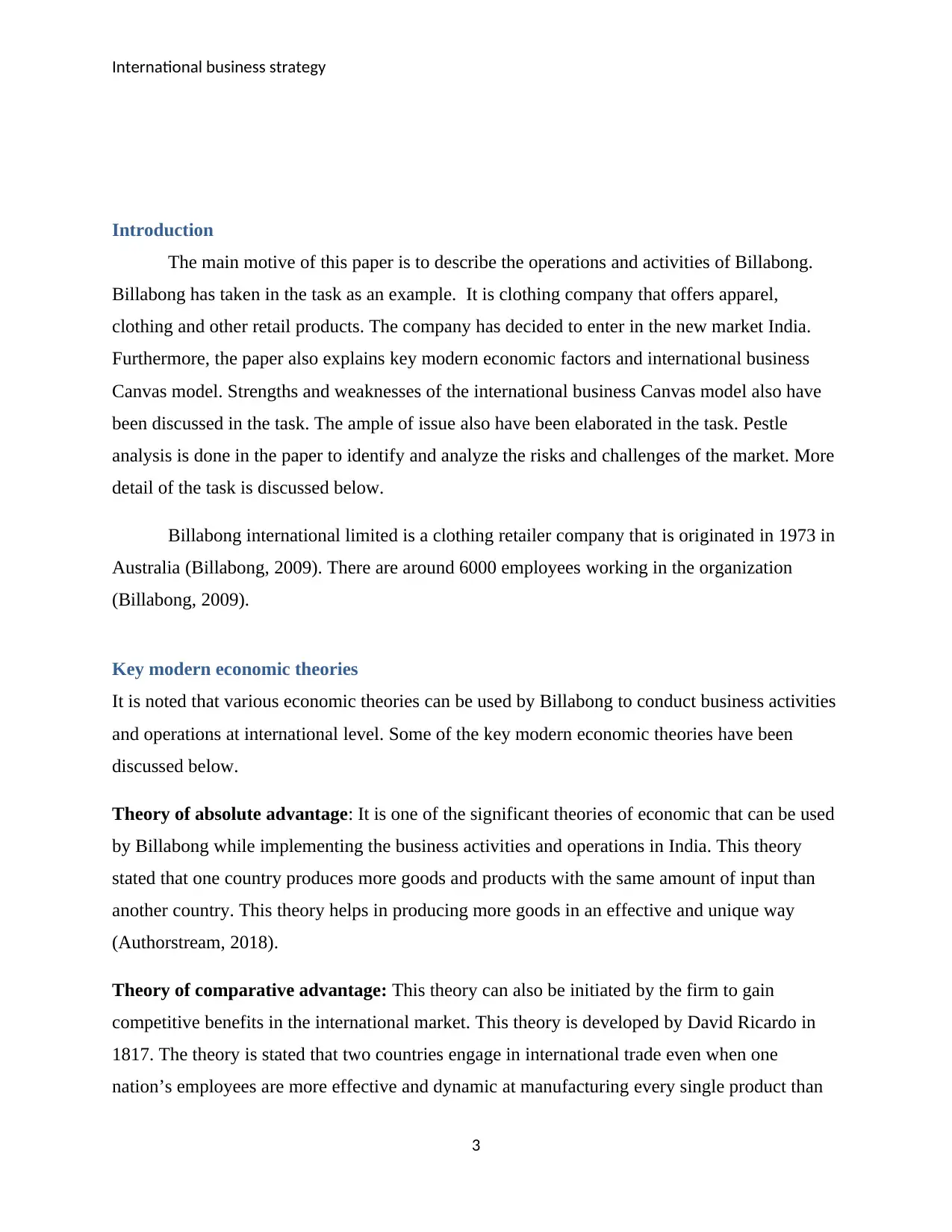
International business strategy
Introduction
The main motive of this paper is to describe the operations and activities of Billabong.
Billabong has taken in the task as an example. It is clothing company that offers apparel,
clothing and other retail products. The company has decided to enter in the new market India.
Furthermore, the paper also explains key modern economic factors and international business
Canvas model. Strengths and weaknesses of the international business Canvas model also have
been discussed in the task. The ample of issue also have been elaborated in the task. Pestle
analysis is done in the paper to identify and analyze the risks and challenges of the market. More
detail of the task is discussed below.
Billabong international limited is a clothing retailer company that is originated in 1973 in
Australia (Billabong, 2009). There are around 6000 employees working in the organization
(Billabong, 2009).
Key modern economic theories
It is noted that various economic theories can be used by Billabong to conduct business activities
and operations at international level. Some of the key modern economic theories have been
discussed below.
Theory of absolute advantage: It is one of the significant theories of economic that can be used
by Billabong while implementing the business activities and operations in India. This theory
stated that one country produces more goods and products with the same amount of input than
another country. This theory helps in producing more goods in an effective and unique way
(Authorstream, 2018).
Theory of comparative advantage: This theory can also be initiated by the firm to gain
competitive benefits in the international market. This theory is developed by David Ricardo in
1817. The theory is stated that two countries engage in international trade even when one
nation’s employees are more effective and dynamic at manufacturing every single product than
3
Introduction
The main motive of this paper is to describe the operations and activities of Billabong.
Billabong has taken in the task as an example. It is clothing company that offers apparel,
clothing and other retail products. The company has decided to enter in the new market India.
Furthermore, the paper also explains key modern economic factors and international business
Canvas model. Strengths and weaknesses of the international business Canvas model also have
been discussed in the task. The ample of issue also have been elaborated in the task. Pestle
analysis is done in the paper to identify and analyze the risks and challenges of the market. More
detail of the task is discussed below.
Billabong international limited is a clothing retailer company that is originated in 1973 in
Australia (Billabong, 2009). There are around 6000 employees working in the organization
(Billabong, 2009).
Key modern economic theories
It is noted that various economic theories can be used by Billabong to conduct business activities
and operations at international level. Some of the key modern economic theories have been
discussed below.
Theory of absolute advantage: It is one of the significant theories of economic that can be used
by Billabong while implementing the business activities and operations in India. This theory
stated that one country produces more goods and products with the same amount of input than
another country. This theory helps in producing more goods in an effective and unique way
(Authorstream, 2018).
Theory of comparative advantage: This theory can also be initiated by the firm to gain
competitive benefits in the international market. This theory is developed by David Ricardo in
1817. The theory is stated that two countries engage in international trade even when one
nation’s employees are more effective and dynamic at manufacturing every single product than
3
⊘ This is a preview!⊘
Do you want full access?
Subscribe today to unlock all pages.

Trusted by 1+ million students worldwide
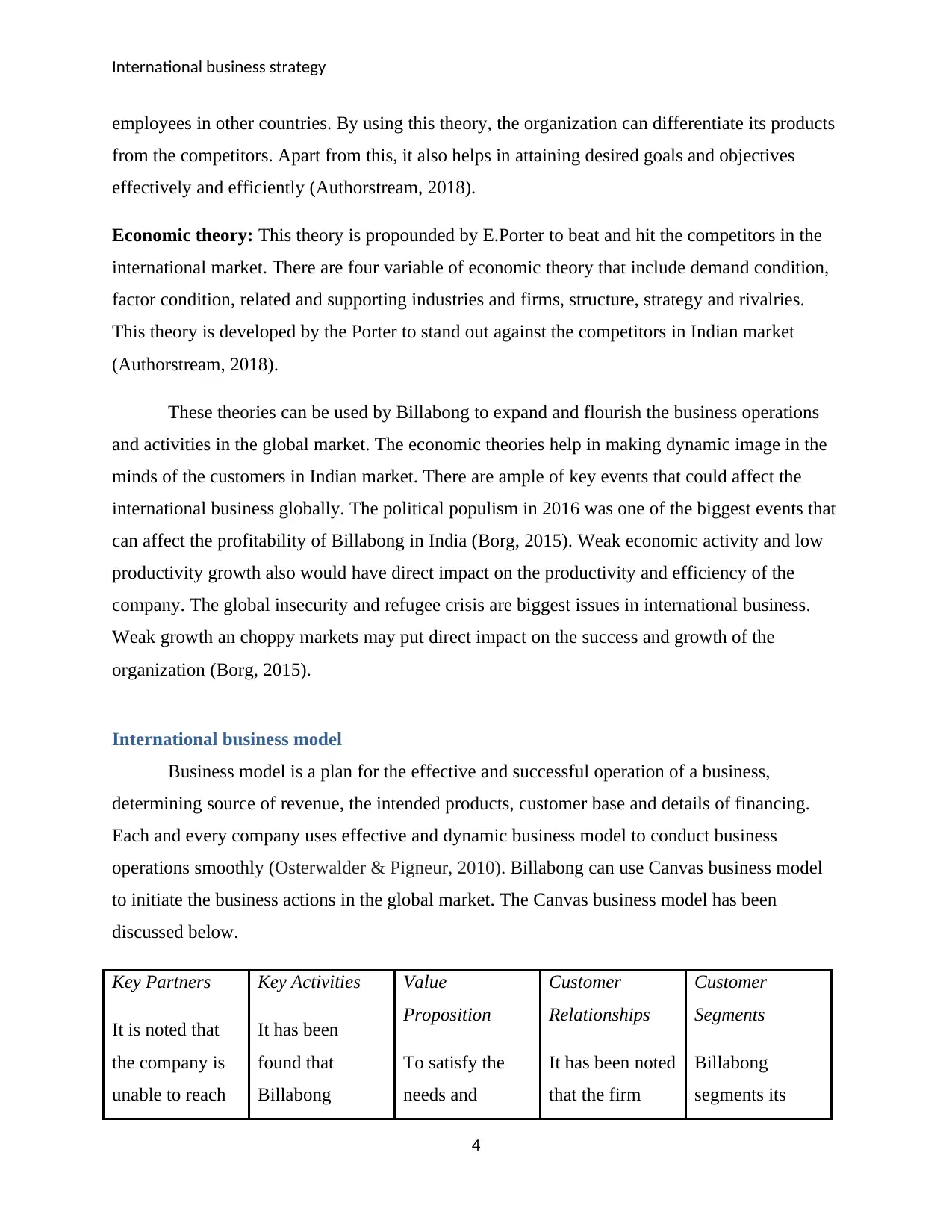
International business strategy
employees in other countries. By using this theory, the organization can differentiate its products
from the competitors. Apart from this, it also helps in attaining desired goals and objectives
effectively and efficiently (Authorstream, 2018).
Economic theory: This theory is propounded by E.Porter to beat and hit the competitors in the
international market. There are four variable of economic theory that include demand condition,
factor condition, related and supporting industries and firms, structure, strategy and rivalries.
This theory is developed by the Porter to stand out against the competitors in Indian market
(Authorstream, 2018).
These theories can be used by Billabong to expand and flourish the business operations
and activities in the global market. The economic theories help in making dynamic image in the
minds of the customers in Indian market. There are ample of key events that could affect the
international business globally. The political populism in 2016 was one of the biggest events that
can affect the profitability of Billabong in India (Borg, 2015). Weak economic activity and low
productivity growth also would have direct impact on the productivity and efficiency of the
company. The global insecurity and refugee crisis are biggest issues in international business.
Weak growth an choppy markets may put direct impact on the success and growth of the
organization (Borg, 2015).
International business model
Business model is a plan for the effective and successful operation of a business,
determining source of revenue, the intended products, customer base and details of financing.
Each and every company uses effective and dynamic business model to conduct business
operations smoothly (Osterwalder & Pigneur, 2010). Billabong can use Canvas business model
to initiate the business actions in the global market. The Canvas business model has been
discussed below.
Key Partners
It is noted that
the company is
unable to reach
Key Activities
It has been
found that
Billabong
Value
Proposition
To satisfy the
needs and
Customer
Relationships
It has been noted
that the firm
Customer
Segments
Billabong
segments its
4
employees in other countries. By using this theory, the organization can differentiate its products
from the competitors. Apart from this, it also helps in attaining desired goals and objectives
effectively and efficiently (Authorstream, 2018).
Economic theory: This theory is propounded by E.Porter to beat and hit the competitors in the
international market. There are four variable of economic theory that include demand condition,
factor condition, related and supporting industries and firms, structure, strategy and rivalries.
This theory is developed by the Porter to stand out against the competitors in Indian market
(Authorstream, 2018).
These theories can be used by Billabong to expand and flourish the business operations
and activities in the global market. The economic theories help in making dynamic image in the
minds of the customers in Indian market. There are ample of key events that could affect the
international business globally. The political populism in 2016 was one of the biggest events that
can affect the profitability of Billabong in India (Borg, 2015). Weak economic activity and low
productivity growth also would have direct impact on the productivity and efficiency of the
company. The global insecurity and refugee crisis are biggest issues in international business.
Weak growth an choppy markets may put direct impact on the success and growth of the
organization (Borg, 2015).
International business model
Business model is a plan for the effective and successful operation of a business,
determining source of revenue, the intended products, customer base and details of financing.
Each and every company uses effective and dynamic business model to conduct business
operations smoothly (Osterwalder & Pigneur, 2010). Billabong can use Canvas business model
to initiate the business actions in the global market. The Canvas business model has been
discussed below.
Key Partners
It is noted that
the company is
unable to reach
Key Activities
It has been
found that
Billabong
Value
Proposition
To satisfy the
needs and
Customer
Relationships
It has been noted
that the firm
Customer
Segments
Billabong
segments its
4
Paraphrase This Document
Need a fresh take? Get an instant paraphrase of this document with our AI Paraphraser
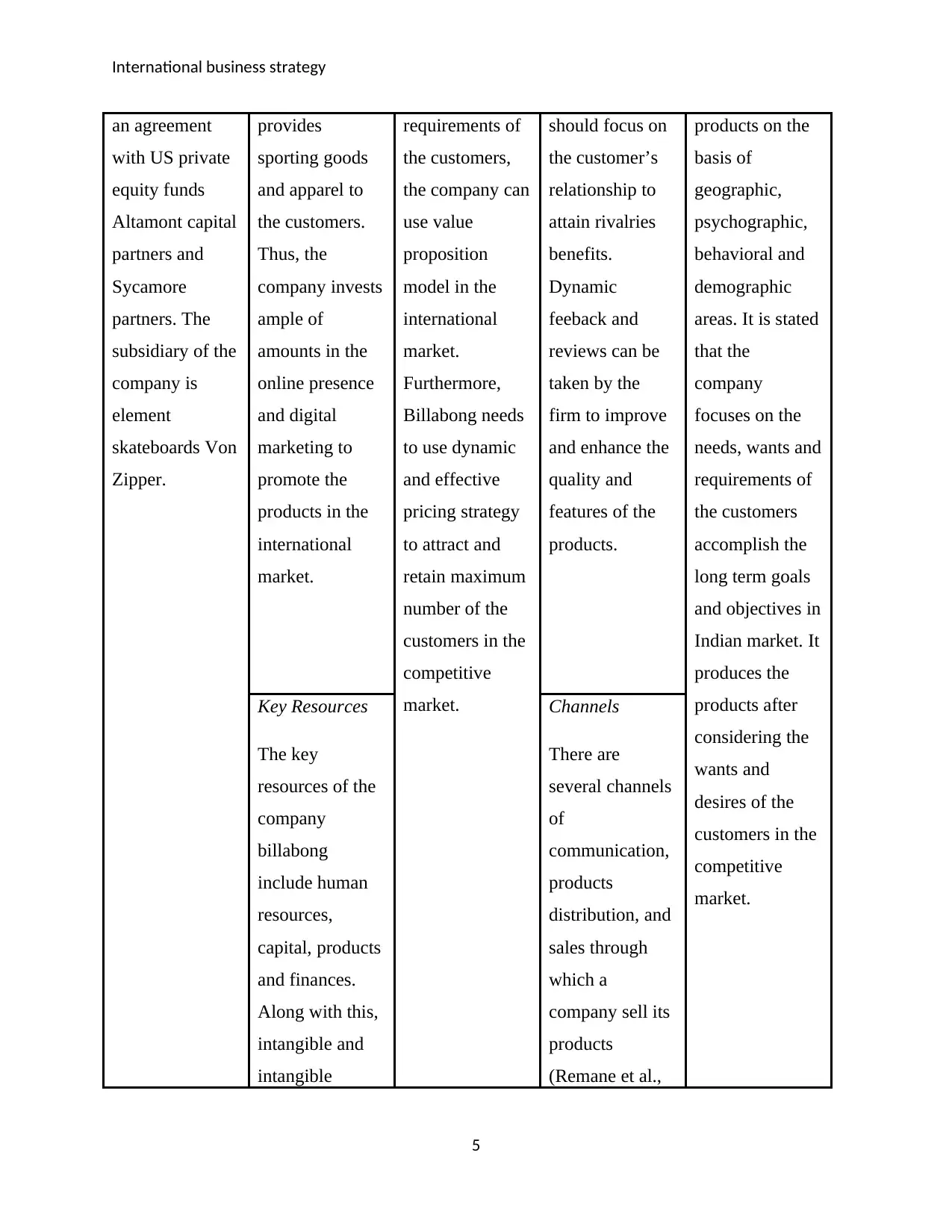
International business strategy
an agreement
with US private
equity funds
Altamont capital
partners and
Sycamore
partners. The
subsidiary of the
company is
element
skateboards Von
Zipper.
provides
sporting goods
and apparel to
the customers.
Thus, the
company invests
ample of
amounts in the
online presence
and digital
marketing to
promote the
products in the
international
market.
requirements of
the customers,
the company can
use value
proposition
model in the
international
market.
Furthermore,
Billabong needs
to use dynamic
and effective
pricing strategy
to attract and
retain maximum
number of the
customers in the
competitive
market.
should focus on
the customer’s
relationship to
attain rivalries
benefits.
Dynamic
feeback and
reviews can be
taken by the
firm to improve
and enhance the
quality and
features of the
products.
products on the
basis of
geographic,
psychographic,
behavioral and
demographic
areas. It is stated
that the
company
focuses on the
needs, wants and
requirements of
the customers
accomplish the
long term goals
and objectives in
Indian market. It
produces the
products after
considering the
wants and
desires of the
customers in the
competitive
market.
Key Resources
The key
resources of the
company
billabong
include human
resources,
capital, products
and finances.
Along with this,
intangible and
intangible
Channels
There are
several channels
of
communication,
products
distribution, and
sales through
which a
company sell its
products
(Remane et al.,
5
an agreement
with US private
equity funds
Altamont capital
partners and
Sycamore
partners. The
subsidiary of the
company is
element
skateboards Von
Zipper.
provides
sporting goods
and apparel to
the customers.
Thus, the
company invests
ample of
amounts in the
online presence
and digital
marketing to
promote the
products in the
international
market.
requirements of
the customers,
the company can
use value
proposition
model in the
international
market.
Furthermore,
Billabong needs
to use dynamic
and effective
pricing strategy
to attract and
retain maximum
number of the
customers in the
competitive
market.
should focus on
the customer’s
relationship to
attain rivalries
benefits.
Dynamic
feeback and
reviews can be
taken by the
firm to improve
and enhance the
quality and
features of the
products.
products on the
basis of
geographic,
psychographic,
behavioral and
demographic
areas. It is stated
that the
company
focuses on the
needs, wants and
requirements of
the customers
accomplish the
long term goals
and objectives in
Indian market. It
produces the
products after
considering the
wants and
desires of the
customers in the
competitive
market.
Key Resources
The key
resources of the
company
billabong
include human
resources,
capital, products
and finances.
Along with this,
intangible and
intangible
Channels
There are
several channels
of
communication,
products
distribution, and
sales through
which a
company sell its
products
(Remane et al.,
5
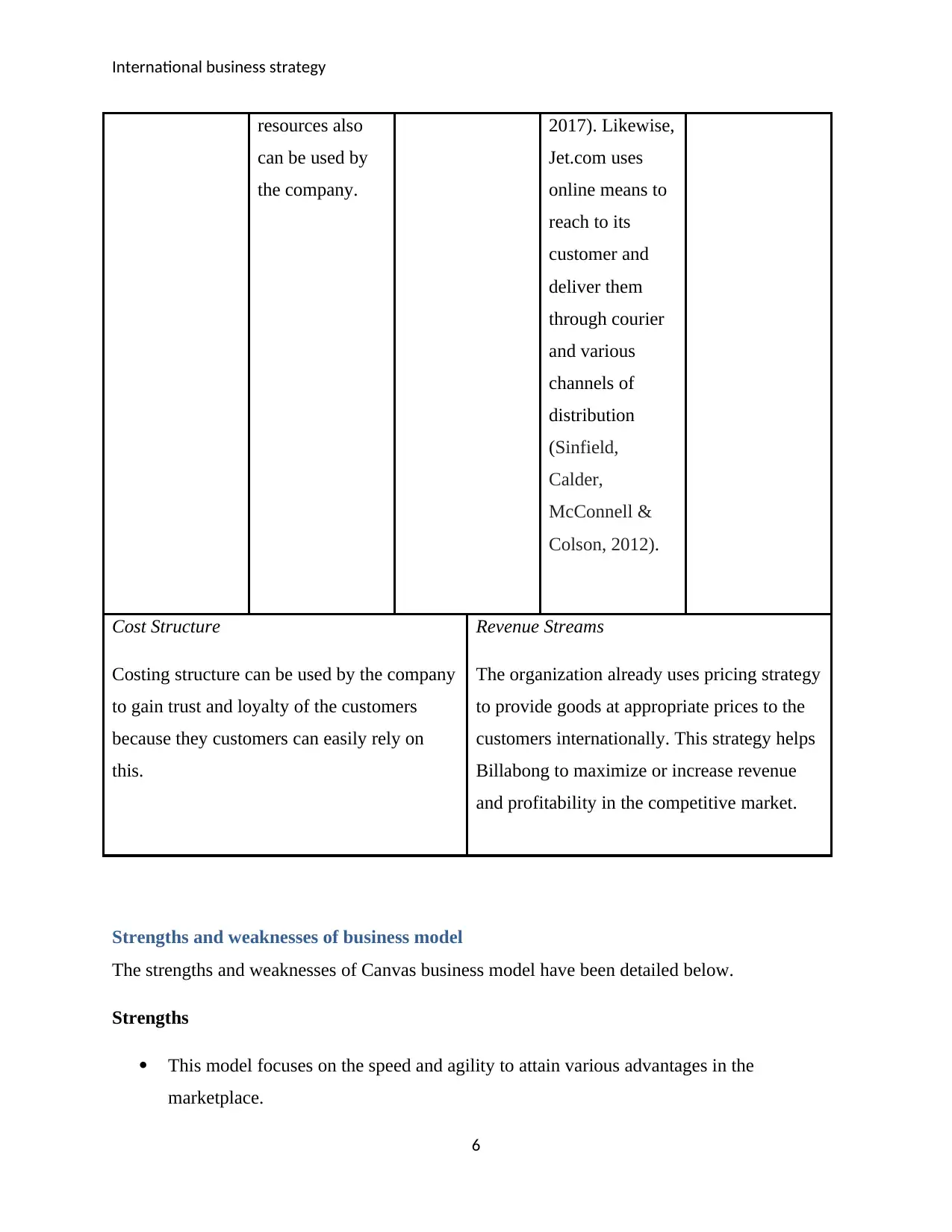
International business strategy
resources also
can be used by
the company.
2017). Likewise,
Jet.com uses
online means to
reach to its
customer and
deliver them
through courier
and various
channels of
distribution
(Sinfield,
Calder,
McConnell &
Colson, 2012).
Cost Structure
Costing structure can be used by the company
to gain trust and loyalty of the customers
because they customers can easily rely on
this.
Revenue Streams
The organization already uses pricing strategy
to provide goods at appropriate prices to the
customers internationally. This strategy helps
Billabong to maximize or increase revenue
and profitability in the competitive market.
Strengths and weaknesses of business model
The strengths and weaknesses of Canvas business model have been detailed below.
Strengths
This model focuses on the speed and agility to attain various advantages in the
marketplace.
6
resources also
can be used by
the company.
2017). Likewise,
Jet.com uses
online means to
reach to its
customer and
deliver them
through courier
and various
channels of
distribution
(Sinfield,
Calder,
McConnell &
Colson, 2012).
Cost Structure
Costing structure can be used by the company
to gain trust and loyalty of the customers
because they customers can easily rely on
this.
Revenue Streams
The organization already uses pricing strategy
to provide goods at appropriate prices to the
customers internationally. This strategy helps
Billabong to maximize or increase revenue
and profitability in the competitive market.
Strengths and weaknesses of business model
The strengths and weaknesses of Canvas business model have been detailed below.
Strengths
This model focuses on the speed and agility to attain various advantages in the
marketplace.
6
⊘ This is a preview!⊘
Do you want full access?
Subscribe today to unlock all pages.

Trusted by 1+ million students worldwide
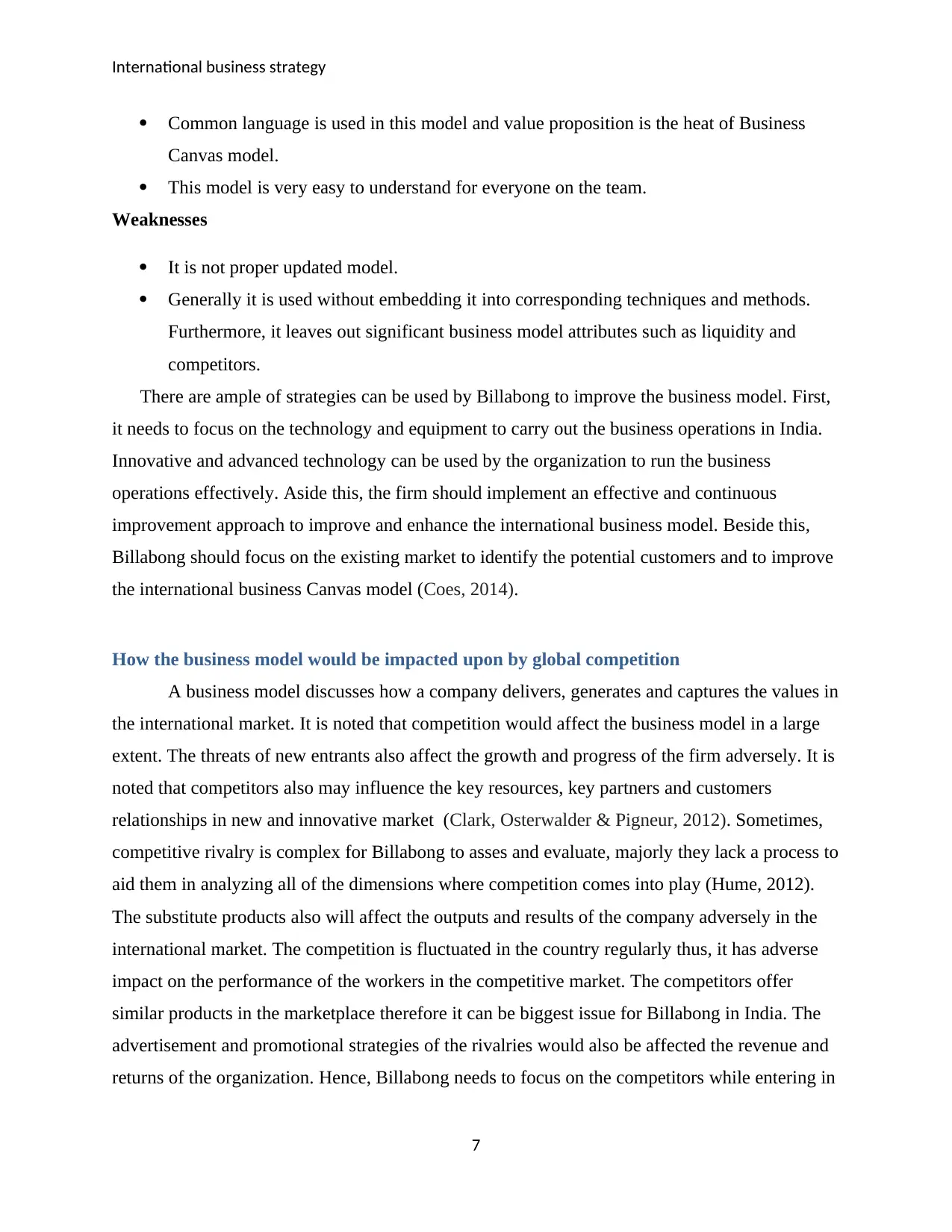
International business strategy
Common language is used in this model and value proposition is the heat of Business
Canvas model.
This model is very easy to understand for everyone on the team.
Weaknesses
It is not proper updated model.
Generally it is used without embedding it into corresponding techniques and methods.
Furthermore, it leaves out significant business model attributes such as liquidity and
competitors.
There are ample of strategies can be used by Billabong to improve the business model. First,
it needs to focus on the technology and equipment to carry out the business operations in India.
Innovative and advanced technology can be used by the organization to run the business
operations effectively. Aside this, the firm should implement an effective and continuous
improvement approach to improve and enhance the international business model. Beside this,
Billabong should focus on the existing market to identify the potential customers and to improve
the international business Canvas model (Coes, 2014).
How the business model would be impacted upon by global competition
A business model discusses how a company delivers, generates and captures the values in
the international market. It is noted that competition would affect the business model in a large
extent. The threats of new entrants also affect the growth and progress of the firm adversely. It is
noted that competitors also may influence the key resources, key partners and customers
relationships in new and innovative market (Clark, Osterwalder & Pigneur, 2012). Sometimes,
competitive rivalry is complex for Billabong to asses and evaluate, majorly they lack a process to
aid them in analyzing all of the dimensions where competition comes into play (Hume, 2012).
The substitute products also will affect the outputs and results of the company adversely in the
international market. The competition is fluctuated in the country regularly thus, it has adverse
impact on the performance of the workers in the competitive market. The competitors offer
similar products in the marketplace therefore it can be biggest issue for Billabong in India. The
advertisement and promotional strategies of the rivalries would also be affected the revenue and
returns of the organization. Hence, Billabong needs to focus on the competitors while entering in
7
Common language is used in this model and value proposition is the heat of Business
Canvas model.
This model is very easy to understand for everyone on the team.
Weaknesses
It is not proper updated model.
Generally it is used without embedding it into corresponding techniques and methods.
Furthermore, it leaves out significant business model attributes such as liquidity and
competitors.
There are ample of strategies can be used by Billabong to improve the business model. First,
it needs to focus on the technology and equipment to carry out the business operations in India.
Innovative and advanced technology can be used by the organization to run the business
operations effectively. Aside this, the firm should implement an effective and continuous
improvement approach to improve and enhance the international business model. Beside this,
Billabong should focus on the existing market to identify the potential customers and to improve
the international business Canvas model (Coes, 2014).
How the business model would be impacted upon by global competition
A business model discusses how a company delivers, generates and captures the values in
the international market. It is noted that competition would affect the business model in a large
extent. The threats of new entrants also affect the growth and progress of the firm adversely. It is
noted that competitors also may influence the key resources, key partners and customers
relationships in new and innovative market (Clark, Osterwalder & Pigneur, 2012). Sometimes,
competitive rivalry is complex for Billabong to asses and evaluate, majorly they lack a process to
aid them in analyzing all of the dimensions where competition comes into play (Hume, 2012).
The substitute products also will affect the outputs and results of the company adversely in the
international market. The competition is fluctuated in the country regularly thus, it has adverse
impact on the performance of the workers in the competitive market. The competitors offer
similar products in the marketplace therefore it can be biggest issue for Billabong in India. The
advertisement and promotional strategies of the rivalries would also be affected the revenue and
returns of the organization. Hence, Billabong needs to focus on the competitors while entering in
7
Paraphrase This Document
Need a fresh take? Get an instant paraphrase of this document with our AI Paraphraser
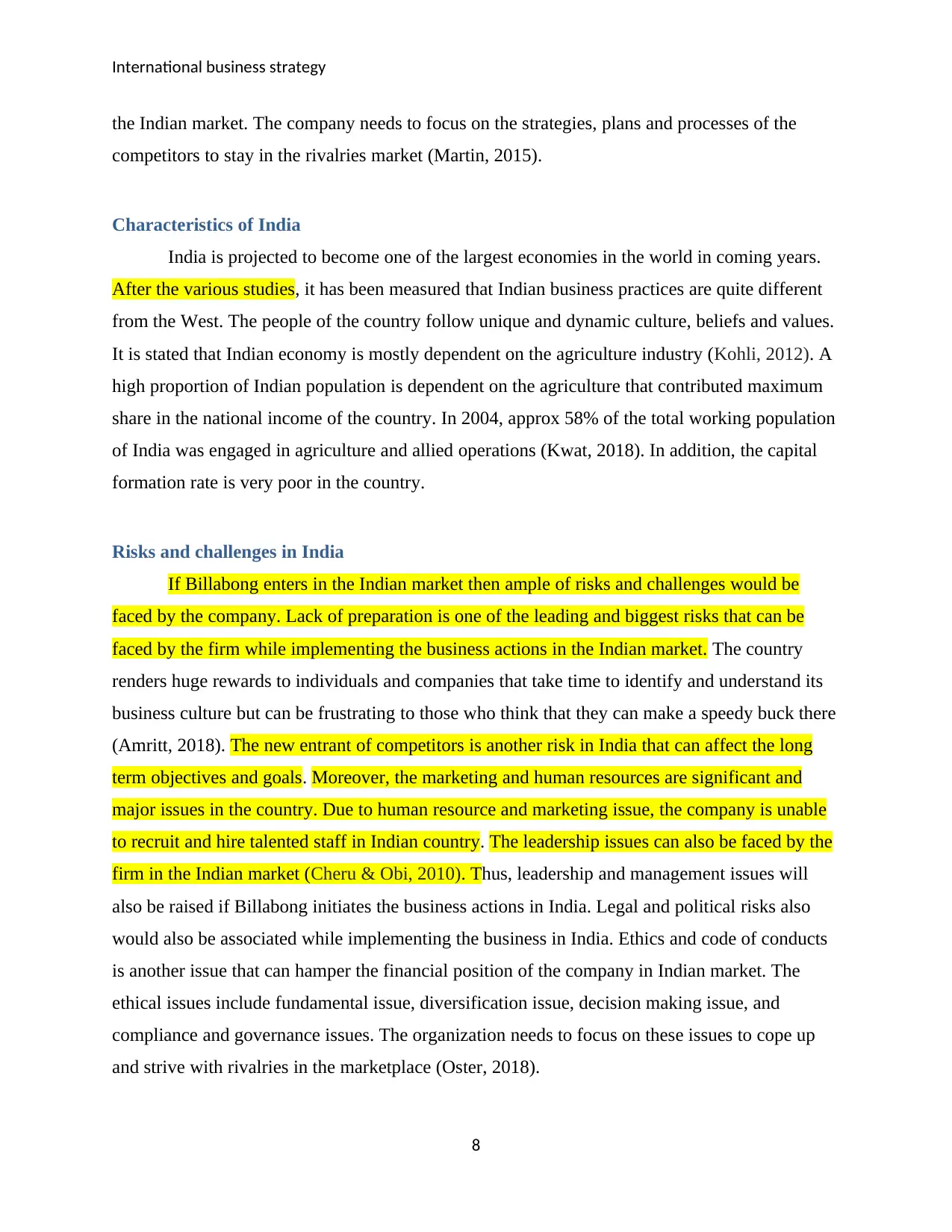
International business strategy
the Indian market. The company needs to focus on the strategies, plans and processes of the
competitors to stay in the rivalries market (Martin, 2015).
Characteristics of India
India is projected to become one of the largest economies in the world in coming years.
After the various studies, it has been measured that Indian business practices are quite different
from the West. The people of the country follow unique and dynamic culture, beliefs and values.
It is stated that Indian economy is mostly dependent on the agriculture industry (Kohli, 2012). A
high proportion of Indian population is dependent on the agriculture that contributed maximum
share in the national income of the country. In 2004, approx 58% of the total working population
of India was engaged in agriculture and allied operations (Kwat, 2018). In addition, the capital
formation rate is very poor in the country.
Risks and challenges in India
If Billabong enters in the Indian market then ample of risks and challenges would be
faced by the company. Lack of preparation is one of the leading and biggest risks that can be
faced by the firm while implementing the business actions in the Indian market. The country
renders huge rewards to individuals and companies that take time to identify and understand its
business culture but can be frustrating to those who think that they can make a speedy buck there
(Amritt, 2018). The new entrant of competitors is another risk in India that can affect the long
term objectives and goals. Moreover, the marketing and human resources are significant and
major issues in the country. Due to human resource and marketing issue, the company is unable
to recruit and hire talented staff in Indian country. The leadership issues can also be faced by the
firm in the Indian market (Cheru & Obi, 2010). Thus, leadership and management issues will
also be raised if Billabong initiates the business actions in India. Legal and political risks also
would also be associated while implementing the business in India. Ethics and code of conducts
is another issue that can hamper the financial position of the company in Indian market. The
ethical issues include fundamental issue, diversification issue, decision making issue, and
compliance and governance issues. The organization needs to focus on these issues to cope up
and strive with rivalries in the marketplace (Oster, 2018).
8
the Indian market. The company needs to focus on the strategies, plans and processes of the
competitors to stay in the rivalries market (Martin, 2015).
Characteristics of India
India is projected to become one of the largest economies in the world in coming years.
After the various studies, it has been measured that Indian business practices are quite different
from the West. The people of the country follow unique and dynamic culture, beliefs and values.
It is stated that Indian economy is mostly dependent on the agriculture industry (Kohli, 2012). A
high proportion of Indian population is dependent on the agriculture that contributed maximum
share in the national income of the country. In 2004, approx 58% of the total working population
of India was engaged in agriculture and allied operations (Kwat, 2018). In addition, the capital
formation rate is very poor in the country.
Risks and challenges in India
If Billabong enters in the Indian market then ample of risks and challenges would be
faced by the company. Lack of preparation is one of the leading and biggest risks that can be
faced by the firm while implementing the business actions in the Indian market. The country
renders huge rewards to individuals and companies that take time to identify and understand its
business culture but can be frustrating to those who think that they can make a speedy buck there
(Amritt, 2018). The new entrant of competitors is another risk in India that can affect the long
term objectives and goals. Moreover, the marketing and human resources are significant and
major issues in the country. Due to human resource and marketing issue, the company is unable
to recruit and hire talented staff in Indian country. The leadership issues can also be faced by the
firm in the Indian market (Cheru & Obi, 2010). Thus, leadership and management issues will
also be raised if Billabong initiates the business actions in India. Legal and political risks also
would also be associated while implementing the business in India. Ethics and code of conducts
is another issue that can hamper the financial position of the company in Indian market. The
ethical issues include fundamental issue, diversification issue, decision making issue, and
compliance and governance issues. The organization needs to focus on these issues to cope up
and strive with rivalries in the marketplace (Oster, 2018).
8
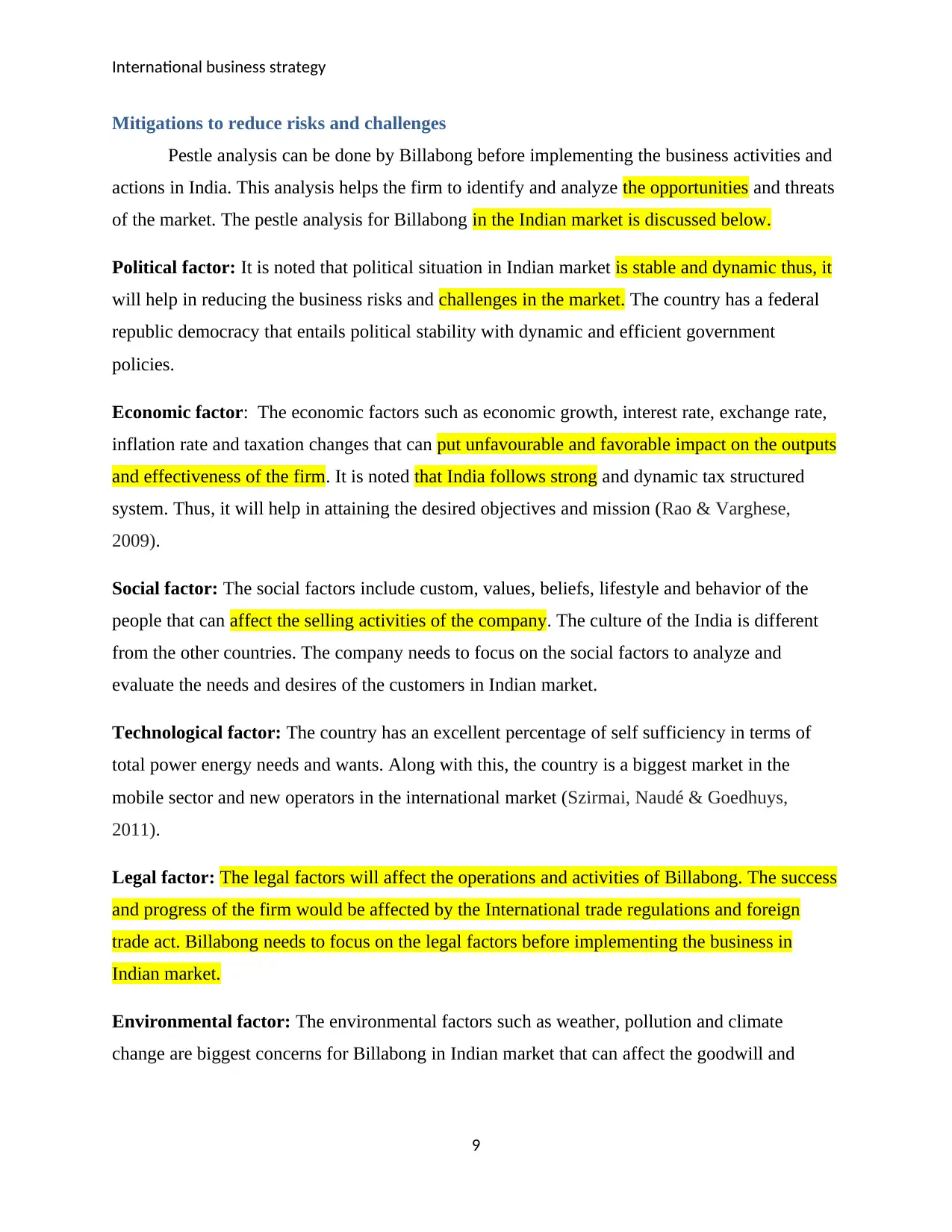
International business strategy
Mitigations to reduce risks and challenges
Pestle analysis can be done by Billabong before implementing the business activities and
actions in India. This analysis helps the firm to identify and analyze the opportunities and threats
of the market. The pestle analysis for Billabong in the Indian market is discussed below.
Political factor: It is noted that political situation in Indian market is stable and dynamic thus, it
will help in reducing the business risks and challenges in the market. The country has a federal
republic democracy that entails political stability with dynamic and efficient government
policies.
Economic factor: The economic factors such as economic growth, interest rate, exchange rate,
inflation rate and taxation changes that can put unfavourable and favorable impact on the outputs
and effectiveness of the firm. It is noted that India follows strong and dynamic tax structured
system. Thus, it will help in attaining the desired objectives and mission (Rao & Varghese,
2009).
Social factor: The social factors include custom, values, beliefs, lifestyle and behavior of the
people that can affect the selling activities of the company. The culture of the India is different
from the other countries. The company needs to focus on the social factors to analyze and
evaluate the needs and desires of the customers in Indian market.
Technological factor: The country has an excellent percentage of self sufficiency in terms of
total power energy needs and wants. Along with this, the country is a biggest market in the
mobile sector and new operators in the international market (Szirmai, Naudé & Goedhuys,
2011).
Legal factor: The legal factors will affect the operations and activities of Billabong. The success
and progress of the firm would be affected by the International trade regulations and foreign
trade act. Billabong needs to focus on the legal factors before implementing the business in
Indian market.
Environmental factor: The environmental factors such as weather, pollution and climate
change are biggest concerns for Billabong in Indian market that can affect the goodwill and
9
Mitigations to reduce risks and challenges
Pestle analysis can be done by Billabong before implementing the business activities and
actions in India. This analysis helps the firm to identify and analyze the opportunities and threats
of the market. The pestle analysis for Billabong in the Indian market is discussed below.
Political factor: It is noted that political situation in Indian market is stable and dynamic thus, it
will help in reducing the business risks and challenges in the market. The country has a federal
republic democracy that entails political stability with dynamic and efficient government
policies.
Economic factor: The economic factors such as economic growth, interest rate, exchange rate,
inflation rate and taxation changes that can put unfavourable and favorable impact on the outputs
and effectiveness of the firm. It is noted that India follows strong and dynamic tax structured
system. Thus, it will help in attaining the desired objectives and mission (Rao & Varghese,
2009).
Social factor: The social factors include custom, values, beliefs, lifestyle and behavior of the
people that can affect the selling activities of the company. The culture of the India is different
from the other countries. The company needs to focus on the social factors to analyze and
evaluate the needs and desires of the customers in Indian market.
Technological factor: The country has an excellent percentage of self sufficiency in terms of
total power energy needs and wants. Along with this, the country is a biggest market in the
mobile sector and new operators in the international market (Szirmai, Naudé & Goedhuys,
2011).
Legal factor: The legal factors will affect the operations and activities of Billabong. The success
and progress of the firm would be affected by the International trade regulations and foreign
trade act. Billabong needs to focus on the legal factors before implementing the business in
Indian market.
Environmental factor: The environmental factors such as weather, pollution and climate
change are biggest concerns for Billabong in Indian market that can affect the goodwill and
9
⊘ This is a preview!⊘
Do you want full access?
Subscribe today to unlock all pages.

Trusted by 1+ million students worldwide
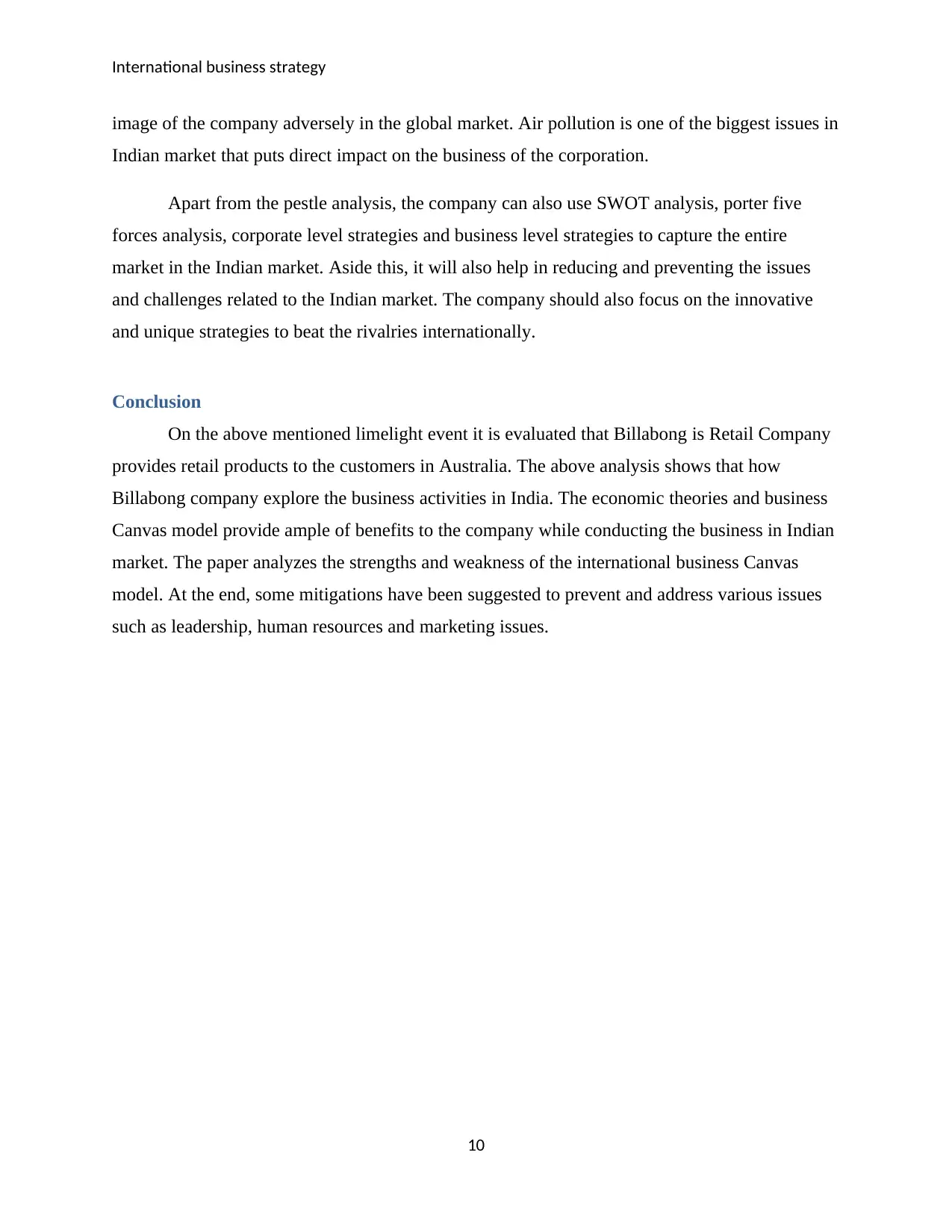
International business strategy
image of the company adversely in the global market. Air pollution is one of the biggest issues in
Indian market that puts direct impact on the business of the corporation.
Apart from the pestle analysis, the company can also use SWOT analysis, porter five
forces analysis, corporate level strategies and business level strategies to capture the entire
market in the Indian market. Aside this, it will also help in reducing and preventing the issues
and challenges related to the Indian market. The company should also focus on the innovative
and unique strategies to beat the rivalries internationally.
Conclusion
On the above mentioned limelight event it is evaluated that Billabong is Retail Company
provides retail products to the customers in Australia. The above analysis shows that how
Billabong company explore the business activities in India. The economic theories and business
Canvas model provide ample of benefits to the company while conducting the business in Indian
market. The paper analyzes the strengths and weakness of the international business Canvas
model. At the end, some mitigations have been suggested to prevent and address various issues
such as leadership, human resources and marketing issues.
10
image of the company adversely in the global market. Air pollution is one of the biggest issues in
Indian market that puts direct impact on the business of the corporation.
Apart from the pestle analysis, the company can also use SWOT analysis, porter five
forces analysis, corporate level strategies and business level strategies to capture the entire
market in the Indian market. Aside this, it will also help in reducing and preventing the issues
and challenges related to the Indian market. The company should also focus on the innovative
and unique strategies to beat the rivalries internationally.
Conclusion
On the above mentioned limelight event it is evaluated that Billabong is Retail Company
provides retail products to the customers in Australia. The above analysis shows that how
Billabong company explore the business activities in India. The economic theories and business
Canvas model provide ample of benefits to the company while conducting the business in Indian
market. The paper analyzes the strengths and weakness of the international business Canvas
model. At the end, some mitigations have been suggested to prevent and address various issues
such as leadership, human resources and marketing issues.
10
Paraphrase This Document
Need a fresh take? Get an instant paraphrase of this document with our AI Paraphraser
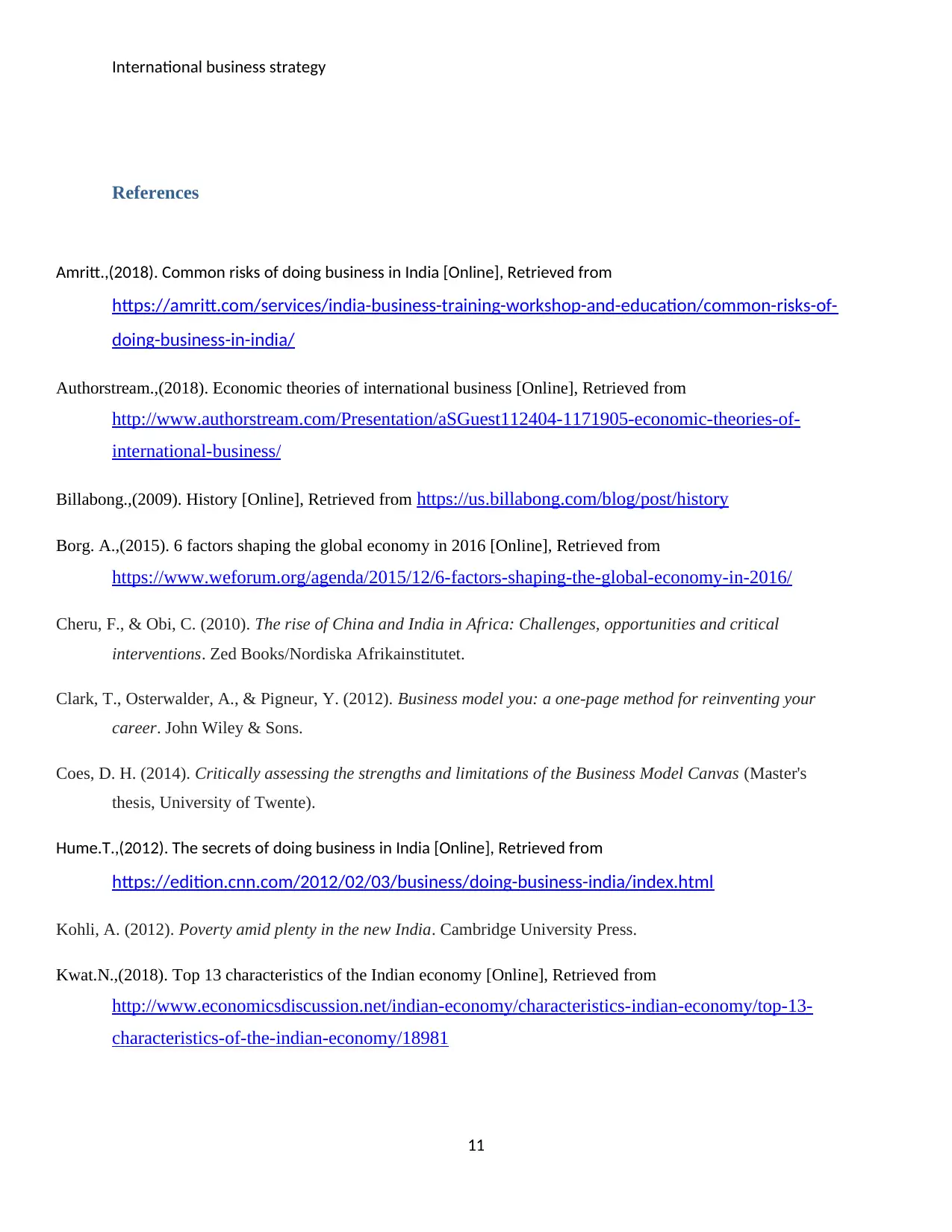
International business strategy
References
Amritt.,(2018). Common risks of doing business in India [Online], Retrieved from
https://amritt.com/services/india-business-training-workshop-and-education/common-risks-of-
doing-business-in-india/
Authorstream.,(2018). Economic theories of international business [Online], Retrieved from
http://www.authorstream.com/Presentation/aSGuest112404-1171905-economic-theories-of-
international-business/
Billabong.,(2009). History [Online], Retrieved from https://us.billabong.com/blog/post/history
Borg. A.,(2015). 6 factors shaping the global economy in 2016 [Online], Retrieved from
https://www.weforum.org/agenda/2015/12/6-factors-shaping-the-global-economy-in-2016/
Cheru, F., & Obi, C. (2010). The rise of China and India in Africa: Challenges, opportunities and critical
interventions. Zed Books/Nordiska Afrikainstitutet.
Clark, T., Osterwalder, A., & Pigneur, Y. (2012). Business model you: a one-page method for reinventing your
career. John Wiley & Sons.
Coes, D. H. (2014). Critically assessing the strengths and limitations of the Business Model Canvas (Master's
thesis, University of Twente).
Hume.T.,(2012). The secrets of doing business in India [Online], Retrieved from
https://edition.cnn.com/2012/02/03/business/doing-business-india/index.html
Kohli, A. (2012). Poverty amid plenty in the new India. Cambridge University Press.
Kwat.N.,(2018). Top 13 characteristics of the Indian economy [Online], Retrieved from
http://www.economicsdiscussion.net/indian-economy/characteristics-indian-economy/top-13-
characteristics-of-the-indian-economy/18981
11
References
Amritt.,(2018). Common risks of doing business in India [Online], Retrieved from
https://amritt.com/services/india-business-training-workshop-and-education/common-risks-of-
doing-business-in-india/
Authorstream.,(2018). Economic theories of international business [Online], Retrieved from
http://www.authorstream.com/Presentation/aSGuest112404-1171905-economic-theories-of-
international-business/
Billabong.,(2009). History [Online], Retrieved from https://us.billabong.com/blog/post/history
Borg. A.,(2015). 6 factors shaping the global economy in 2016 [Online], Retrieved from
https://www.weforum.org/agenda/2015/12/6-factors-shaping-the-global-economy-in-2016/
Cheru, F., & Obi, C. (2010). The rise of China and India in Africa: Challenges, opportunities and critical
interventions. Zed Books/Nordiska Afrikainstitutet.
Clark, T., Osterwalder, A., & Pigneur, Y. (2012). Business model you: a one-page method for reinventing your
career. John Wiley & Sons.
Coes, D. H. (2014). Critically assessing the strengths and limitations of the Business Model Canvas (Master's
thesis, University of Twente).
Hume.T.,(2012). The secrets of doing business in India [Online], Retrieved from
https://edition.cnn.com/2012/02/03/business/doing-business-india/index.html
Kohli, A. (2012). Poverty amid plenty in the new India. Cambridge University Press.
Kwat.N.,(2018). Top 13 characteristics of the Indian economy [Online], Retrieved from
http://www.economicsdiscussion.net/indian-economy/characteristics-indian-economy/top-13-
characteristics-of-the-indian-economy/18981
11
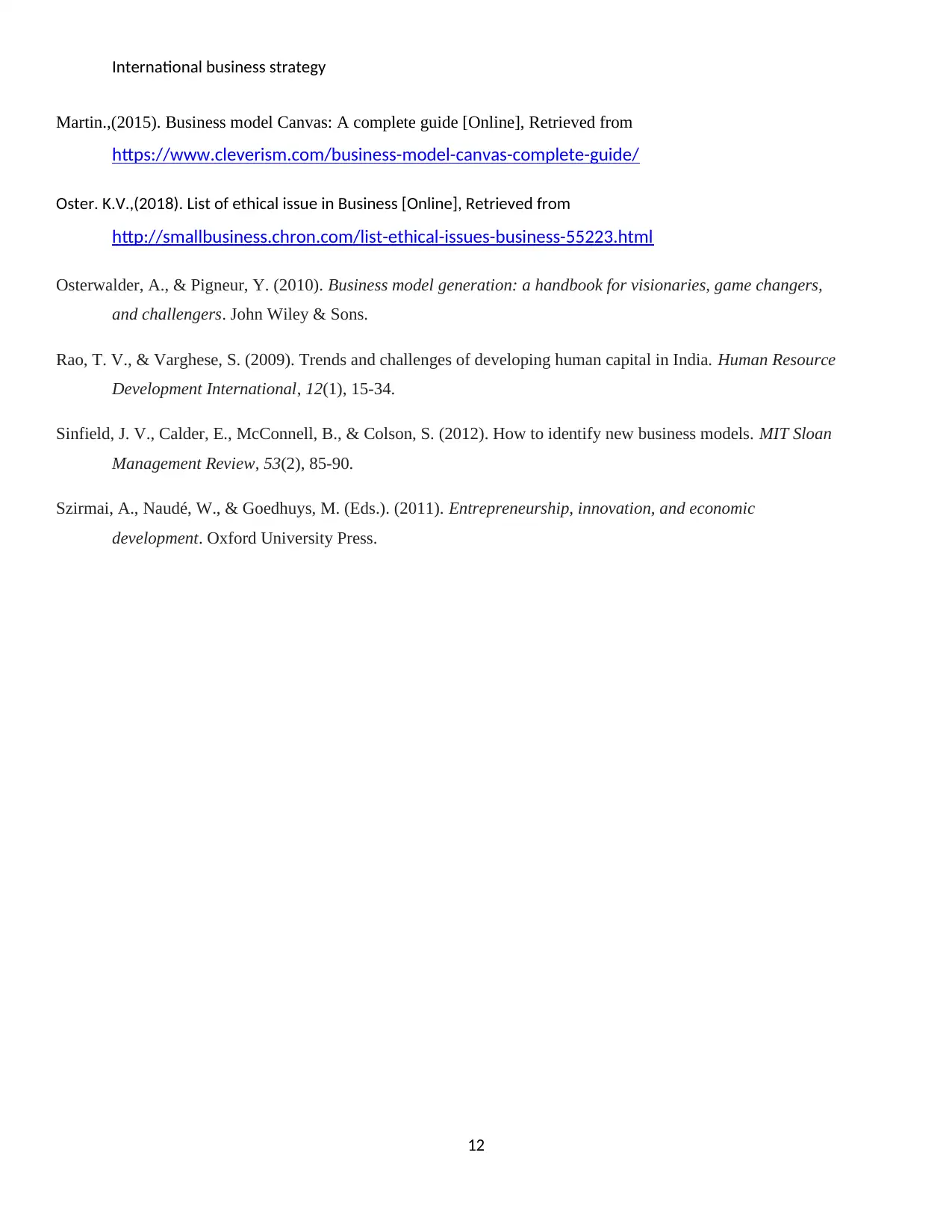
International business strategy
Martin.,(2015). Business model Canvas: A complete guide [Online], Retrieved from
https://www.cleverism.com/business-model-canvas-complete-guide/
Oster. K.V.,(2018). List of ethical issue in Business [Online], Retrieved from
http://smallbusiness.chron.com/list-ethical-issues-business-55223.html
Osterwalder, A., & Pigneur, Y. (2010). Business model generation: a handbook for visionaries, game changers,
and challengers. John Wiley & Sons.
Rao, T. V., & Varghese, S. (2009). Trends and challenges of developing human capital in India. Human Resource
Development International, 12(1), 15-34.
Sinfield, J. V., Calder, E., McConnell, B., & Colson, S. (2012). How to identify new business models. MIT Sloan
Management Review, 53(2), 85-90.
Szirmai, A., Naudé, W., & Goedhuys, M. (Eds.). (2011). Entrepreneurship, innovation, and economic
development. Oxford University Press.
12
Martin.,(2015). Business model Canvas: A complete guide [Online], Retrieved from
https://www.cleverism.com/business-model-canvas-complete-guide/
Oster. K.V.,(2018). List of ethical issue in Business [Online], Retrieved from
http://smallbusiness.chron.com/list-ethical-issues-business-55223.html
Osterwalder, A., & Pigneur, Y. (2010). Business model generation: a handbook for visionaries, game changers,
and challengers. John Wiley & Sons.
Rao, T. V., & Varghese, S. (2009). Trends and challenges of developing human capital in India. Human Resource
Development International, 12(1), 15-34.
Sinfield, J. V., Calder, E., McConnell, B., & Colson, S. (2012). How to identify new business models. MIT Sloan
Management Review, 53(2), 85-90.
Szirmai, A., Naudé, W., & Goedhuys, M. (Eds.). (2011). Entrepreneurship, innovation, and economic
development. Oxford University Press.
12
⊘ This is a preview!⊘
Do you want full access?
Subscribe today to unlock all pages.

Trusted by 1+ million students worldwide
1 out of 12
Related Documents
Your All-in-One AI-Powered Toolkit for Academic Success.
+13062052269
info@desklib.com
Available 24*7 on WhatsApp / Email
![[object Object]](/_next/static/media/star-bottom.7253800d.svg)
Unlock your academic potential
Copyright © 2020–2025 A2Z Services. All Rights Reserved. Developed and managed by ZUCOL.





